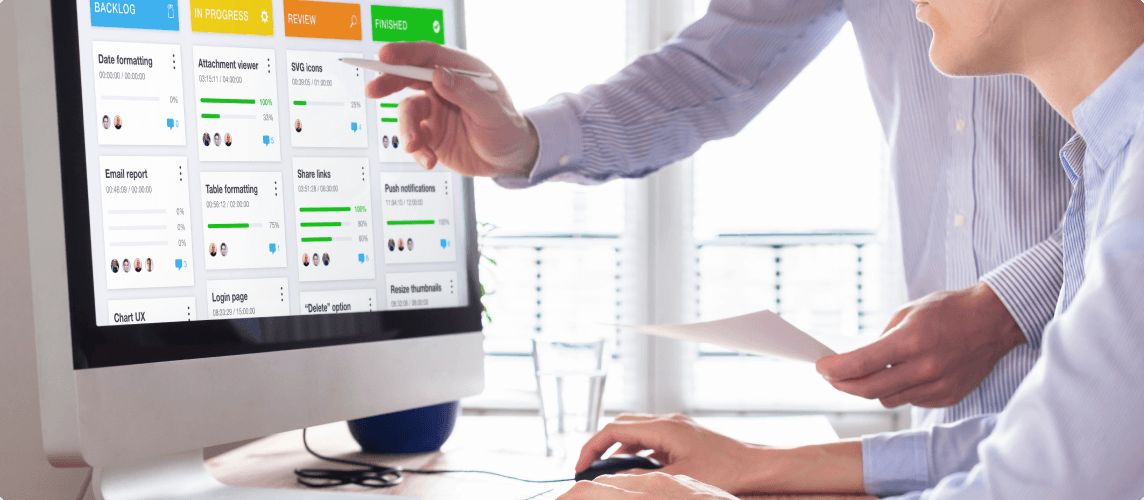New website vs. Customer XP
When building or redesigning a website, you are not creating your place on the web. You design consumer experiences.
... it is enough to make a nice website for the sale to skyrocket...",
"A good product will sell itself...",
"... I don't like this design...",
"Enlarge the logo, product photo and "buy" button... ".
Fortunately, fewer and fewer web design processes look like this.
Along with the development of the Internet, the opportunities it gives, and the constant changes in consumer expectations, the awareness of what people expect is also increasing among brands. We know that the customer not only buys a slider but also a "moment" - an idea that makes him identify with your brand / product or not.
Consumers are inundated with lots of offers, and they make subconscious decisions quickly. You don't have much time. It takes just a few seconds for an association to arise in the mind of your client. Fortunately, you have an influence on whether it will be positive or not ...
Modern technologies have a lot to offer, but their effectiveness will be useless if you do not match them with the expectations of your client. You need to get to know this people and the emotions that drive them, because only thanks to this you will learn how to use the possibilities of IT tools in the most effective way.
Before choosing a technology, stop for a moment and follow the footsteps of your customer.
Check the path he took before the actual purchase. Only while having all this information you can take the action.
There are many solutions on the market designed for managing the content, layout, and publication of your website. They differ from each other, among others with the scope of functionality and the level of advancement of the platform.
The decision to choose the right CMS (Content Management System) should be based on its individual features and functions. They should be analysed on the basis of the knowledge of the client, and his current and future needs. The more precise this picture is, the better.

It's a good idea to start from scratch and check what tools you'll need in the first place.
- Intuitive and flexible content and layout editor
This is absolutely essential because you'll be using it most often. Simple handling will facilitate the process of design of the content layout in accordance with WCAG and UX. It is nice when it is equipped, for example, with a photo gallery or supports mp4 recordings.
Presenting products in many forms with an additional description has a much better chance of attracting the attention of potential buyers. It is also important to pay attention to whether the system has tools for translation into other languages, thanks to which it will be easier for you to attract a large group of customers.
- Workflow for publishing subpages
Very useful when lots of people are involved in the process of content creation. It supports the publication process and product or service management. As an example: a product is placed in the form of a record in a data repository, then it is assigned to a specific catalogue in the database and added to a product group. Then it reaches the team responsible for the layout, content, and multimedia. In the next phase, the whole thing is verified until it is published.
- Data security mechanisms (including personal data)
Among the administrative settings, you will find System of roles and authorities. This is the most popular way to protect data, e.g. against unwanted changes to the content or layout. It consists in assigning each user of the platform not only a specific role but also authorities.
For example, the content authorizer will accept or reject the changes made by the content creator. On the other hand, another user creating graphics will not be able to change e.g. the SKU number. Every item can be simply hidden or inactive for him.
It is also worth remembering that in addition to the standard SSL encryption certificates, there are other authorization methods, e.g. 2FA (2 Factor Authorization), i.e. multi-level logging. Each user having access to the platform must confirm their identity in not one, but two steps. For example, by entering the password and then the code from the text message.
Remember also about the mechanisms supporting compliance with the rules of personal data processing. They must be compatible with the location of your customers in a given part of the world. In the case of Europe, it will be the GDPR, and in the United States, the CCPA (from 2018).
- Elements characteristic for e-Commerce
The Cloud platform provides better efficiency and stability of systems. Even during periods of peak traffic, e.g. Black Friday, when customers want to take advantage of unique promotions.
What's more, the service is available almost all the time because of HA - high availability. Worth mentioning are the almost unlimited expansion possibilities that you gain thanks to scalability in terms of functionality or even expansion of IT resources.
BI or Power BI (Business Intelligence) tools. One of the most characteristic elements of the widely understood business analytics are, among others dashboards. These are graphical representations of data collected from many sources and analysed in real time.
Thanks to them, you gain a broad perspective for business activities related not only to achieving indicators, but also measuring customer experience in relation to specific elements and operation of the website.
- Personalization of experiences
The individual customer is the main goal of personalization. Within its functions you will find, among others sending notifications about the availability of products marked by users as favourites, displaying proposed products, any form of delivery or payment, as well as testing the intuitiveness of website navigation by the user (A / B testing).
However, it can be noticed that B2B customers are more and more often in the centre of interest close to individual customers. Many of the aspects are the same, but some of them differ due to the needs of the salespeople. In this case, the smooth management of the assortment is a big problem, because it is dispersed in many systems and comes from many sources.
The aim is to centralize this data using dedicated integrations. Because of that, information about the availability and location of products is displayed in the system in real time.
This is beneficial for the sellers because they can configure, for example, notifications about a low stock level of a given product, or even an automatic order of the next consignment. However, there are many examples of process personalization in eCommerce, and each of them has a positive influence on the customer's experience.
Ready to revolutionize your website?
Features of a good CMS
An important aspect is how the CMS is built. You can choose from a traditional CMS model where the entire system is an integral whole: the front-end and back-end function within one platform, as well as systems with separate front-end and back-end layers. We are talking about Headless CMS and Decoupled CMS.
The headless model remodels the approach to the presentation layer, using the API interface to send content to any place and in this case, it is the channel that receives the data that is responsible for the visual layout of the content. This accelerates the launch of products on the market with the use of multiple sales channels. In this way, you gain access to content unified in one place, which you can then share immediately on multiple devices.

What are the benefits for customers?
Regardless of the device on which they run the website, both the layout and the content are adapted to the device, ensuring the best possible user experience. What's more, saving the product in the basket on your smartphone will also be visible when browsing the store's website on a PC or Smart TV.
Stable synchronization of the channels and the content of pages in the case of Headless CMS greatly affects the comfort of users. Headless also drives scalability, it adjusts not only the displayed content to the device but the available resources to keep the website running smoothly and stable.
The decoupled model retains all the features of the headless model and additionally takes into account the presentation layer. Decoupled CMS provides templates that can optionally be used to prepare content for presentation, and then send them to a specific display environment.

Create further experiences
The information base from CMS is the basis of activities, and thanks to their analysis, you get unquestionable and objective feedback on whether and to what extent these activities were effective in creating loyal customers. It's up to you how successful you will build customers' experience and loyalty for the brand.
With CMS you create and modify the content of entire pages. However, if the functionalities contained in the CMS are not enough, it is worth remembering that you can experiment with the content and functions of the system on a large scale - you only need to implement additional functionalities or integrate them with other systems used in the company.
In this way, you can automate a large part of your work and, importantly, increase its efficiency. So what set of tools or functions can you additionally equip the CMS (Content Management System) with?
- Customer Features
Among the most obvious ones regarding real-time interactions, you will find, among others, chatbots. Customers can ask questions, e.g. regarding the regulations, and solve more complicated questions with the help of consultants. It is also worth ensuring the possibility of using mobile applications.
Thanks to the synchronization between the channels, the so-called omnichannel, e.g. saved products will be available from the level of each device.
Customers also love various types of loyalty programs, and are also willing to share their opinions about products. They also increasingly use gift cards. From the perspective of the seller, it is important to be able to organize marketing campaigns for seasonal sales or send special discount coupons. Therefore, on the way to building loyalty, it is worth considering also making this option available.
As part of personalization, you should also add the option to choose a payment method. From credit cards, BLIK, IKO, to e-wallets such as PayPall. And for more technically advanced, multi-currency prepaid cards from e.g. Revolut.The same applies to the forms of receiving orders or free returns.
- Extensive tools for CI (Contextual Intelligence)
The client is not only a collection of basic data: age, gender, location, or search history. Real knowledge about the customer is the contextual one that relates to the entirety of his presence on the Internet. Lifestyle, owned devices or language skills. Combining and analysing these data gives you a real idea of the consumer. But why does that matter? For instance to be able to meet his current and future expectations.
The basic example of activities to meet the expectations of customers is, among others automatic matching of the website language to the user on the basis of his location. Another example of using contextual knowledge is, for example, offering related products to the user.
Buying a mountain backpack may generate several more thematic product recommendations and display the message "Are you going to the mountains? It may be also useful… ”. Moreover, the same user can search for or buy products of a specific brand, then such a message could have been "Do you like the products of X? Find out, what we have prepared for you."
You can also use CI in situations when the user does not like something. For example, he / she issued a negative opinion about a given brand's product or had a problem with finding the item - then you can get information from him about what was the reason for this. Supposing he was not satisfied not with the purchased item, but with a particular brand.
The appearance of the message "We are sorry that you did not like the product. Do you want brand X products to be visible in search results in the future? " will then help to define his purchasing preferences.
- Systems designed to manage product data
PIM (Product Information Management) systems transcend the functionalities offered by the CMS itself. They focus on managing product-related content, i.e. product descriptions, photos, specifications, prices.
They enrich product information and keep it accurate and always up-to-date, no matter how many communication channels are used. Storing product data in such a central repository allows access to them not only from various communication channels but also makes it possible to use them in marketing materials.
PIM can be integrated with a CMS, which will automate updates and making any changes to the content of your website. In this case, a lot of detailed information about the products will be stored and edited in one place, and then fed into the CMS as well as other e-commerce tools, helping your brand to become as customer-oriented as possible. With a solid PIM implementation you can provide better CX.
DAM is used to manage digital assets in the enterprise. DAM is an opportunity to quickly find and share the company's resources with a wide group of users. The tool is designed to give you hassle-free usage of your multimedia library from one place. It has an impact on the presentation of the product but is also important in the preparation of marketing materials, e.g. thanks to the web-to-print function.
Distribution takes place on the digital plane. Customers receive information about products, promotions, incl. in the form of e-mails, push notifications, or advertising banners. It is possible to send MMS or its improved version RCS. All this to make the customer feel the presence of the brand at every step. The CMS and DAM integration increases the efficiency of both tools and makes it easier to streamline digital workflows.
DAM enables you make better use of the potential of the possessed resources. We will advise you on how to do it in an optimal way.
- Integrations with advanced business and analytical systems and Data Centre.
In the era of automation and digitization, there are many tools that drive sales on many levels More and more companies see the enormous business potential in platforms or analytical tools that until recently were the domain of other sectors of the economy, e.g. production. The e-commerce industry discovers their use in complex IT solutions, three extremely advanced areas.
1. Planning of business models and optimization of digital processes:
- BPM (Business Planning Management)
- MRM (Marketing Resource Management)
- BI (Business Intelligence)
2. Data analysis and Cognitive computing (Intelligent data processing)
- Predictive analytics
- Artificial Intelligence
- Machine learning
3. Managing data warehouses:
- CRM (Customer Relationship Management)
- MDM (Master Data Management)
The choice of platform depends on digital maturity
Content Management System, as the name suggests, it was created for a specific purpose - content management. You can choose it today, and upgrade it with new functionalities with time.
An undeniable fact is that with the development of the business, its needs grow and the implementation of more advanced solutions will be necessary after a while. There are many ready-made tools that go far beyond the process of creating standard websites. They focus on automation, data analysis, and experimenting with page content. However, the basis is always the CMS.
Getting to know and building the customer experience is gradual. It is similar with the digital maturity of any company. The whole process, however, requires the ability to adapt and use new technologies. A handy hint here is when you start to notice that the current system is constraining you. It's almost certain that your customers share your feelings. This means that it is high time to change and you should look for a more advanced tool.
Remember, you don't have to do this alone. You can do it together with your customers and build not only a website or customer experience but also your own digital maturity.


















